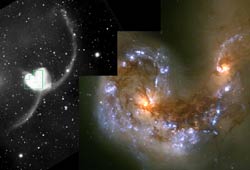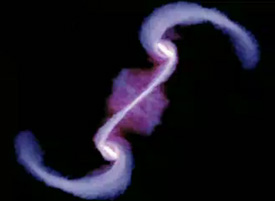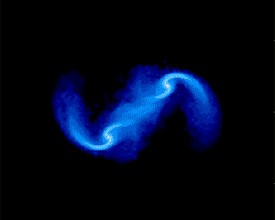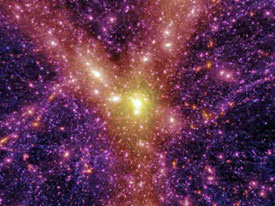
A color view from the Hubble Space Telescope shows the Antennae, two spiral galaxies in Corvus in the process of merging. This system gets its nickname from the long tidal tails visible in the accompanying ground-based, black-and-white image. The Antennae give us a sneak preview of what will happen when our Milky Way Galaxy collides with the Andromeda Galaxy (M31) billions of years from now. Click on the image to see a larger version.
Courtesy Brad Whitmore / STScI / NASA.
When galaxies collide, fireworks ensue. No stars actually bump into each other, but the merger of two large galaxies usually triggers major bursts of star formation in both galaxies as interstellar gas clouds collide and collapse under the strain of the changing gravitational forces.
But that's not the end of the show, as Robert Irion explains in the cover story of the July 2006 issue of Sky & Telescope magazine. If both galaxies harbor supermassive black holes, the two monsters will lock each other into a tight gravitational embrace and settle into a mutual orbit. As the black holes' gravity scatters stars into the far reaches of the galaxy, the systems draw ever closer. Eventually the galaxies — and the black holes — will merge into one.
Gas falling toward the monster black hole heats up and generates a torrent of radiation streaming out of the central region of the newly merged galaxy. A quasar is born sometime during or after this process. Powerful winds blowing off the black hole's accretion disk sweep gas out of the galaxy, often leaving behind a "red and dead" elliptical galaxy.
These large-scale processes unfold over hundreds of millions of years. Since astronomers cannot learn about galaxy mergers by watching them evolve in real time, they gain insight into these violent events by simulating them on computers. They write complex programs that include all the relevant physics, then feed them into distributed networks of computers that crunch the numbers. The computers churn out animations such as those shown on this page.
After August 1, 2006, Robert Irion's article "A Quasar in Every Galaxy?" will be available for download as a PDF file from the S&T Magazine Archive.

This supercomputer simulation depicts two spiral galaxies merging to form an elliptical galaxy. It's available for download by anonymous FTP in three formats: 3.2-megabyte MOV, 5.8-megabyte MPG, and 21.9-megabyte AVI.
Courtesy P. Hopkins / L. Hernquist / V. Springel.

This simulation also shows the merger of two large spiral galaxies. Note the long tails; they are streams of stars and gas ripped out of both galaxies due to tidal interactions. Click on the image to view the 1.3-megabyte animated GIF.
Courtesy P. Hopkins / L. Hernquist / V. Springel.

The Millennium Run simulates the evolution of the universe's large-scale structure. An international collaboration of scientists performed this simulation at the Max Planck Society's Supercomputer Center in Garching, Germany. The team used more than 10 billion particles to trace how dark matter and normal matter coalesce into filaments and galaxy clusters that surround immense voids. The cube represents a volume of space 2 billion light-years across. The computer code includes violent galaxy processes that occur during mergers, which helps produce a simulated universe that closely resembles the real one. For more information, see the Max Planck Society's press release. The simulation is available for download by anonymous FTP as a 58.8-megabyte AVI.
Courtesy Max Planck Institute for Astrophysics / V. Springel / S. White & others.
 0
0
Comments
You must be logged in to post a comment.